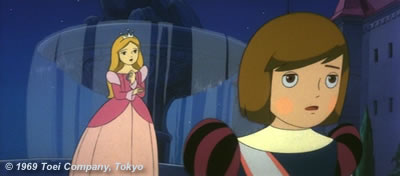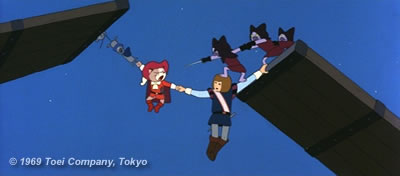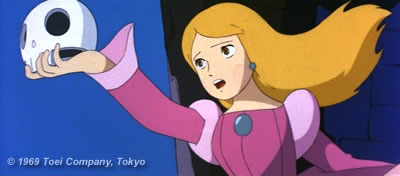| Specifications and version history |
... began in summer 2002 in Germany, when a few people started independently
of each other to search via the Internet for an unforgettable cinema experience
from childhood days: an animated cartoon created in 1969 by the Toei studios
in Tokyo, "Puss in boots" (Nagagutsu wo haita neko). This
80-minute colourful fairy tale was the first large world success  and
the international break-through of the Japanese cartoon art. And so far, for
many people it is still one of their most beautiful examples. Nevertheless,
since the end of the 70's no cinema rental business could itself decide to present
this movie again. And after it was shown on the television for the last time
on the 31st December 1985, this classical has disappeared completely from the
German media market.
and
the international break-through of the Japanese cartoon art. And so far, for
many people it is still one of their most beautiful examples. Nevertheless,
since the end of the 70's no cinema rental business could itself decide to present
this movie again. And after it was shown on the television for the last time
on the 31st December 1985, this classical has disappeared completely from the
German media market.
In the age of Internet and worldwide shopping possibilities it is not too
difficult to find the film itself. For some years it can be ordered on DVD
in the Japanese original sound, the English version was released on VHS tape
in the USA several times, it is even sold in Russia, and a good huntsman in
the "ebay grounds" can track down it even in German language, on
a VHS cassette brought out in old days by the company Toppic under
the FRG cinema title "Perix der Kater und die drei Mausketiere".
That the fan community was still not content was due to the fact, that there are two German language versions of this movie, like many others from the period of splitted Germany. Both versions are so different that they are like two absolutely different films. For example, the West German version on the Toppic video cassette not only renames the tomcat "Pero" as "Perix", but pulls also the remaining naming by all force to the "Grimm brothers" - although the movie is based on the French fairy tale version by Charles Perrault. The other version produced by the East German DEFA studios showed incomparably more linguistic and cultural sensitiveness. And the much greater success of the movie in East Germany agreed to the DEFA studios.
However, the DEFA version remained a vague memory for a long time. Inquiries to television broadcasting stations, film archives and legal successors with the request to either show it again or to sell a recording of it for private use (what is easily possible in many cases) had as response the reference to missing publication rights, speculations about an archive fire, or just a silent shrug. Besides, video recorders have been available in the GDR only since 1989, that is four years after the "Puss in boots" had been shown for the last time on TV. The chance that at that time somebody has taped the film, is very slim, and in fact no private video recording could be discovered to this day. "Pero" was missing for nearly 20 years.

Finally, things started to get better when it became known to the little group of dedicated "Puss investigators", that there was a private audio tape recording of the mentioned last telecast in the New Year's Eve afternoon in 1985! And not only of this, but also of the second "Puss movie" in East German cinemas, "Puss in boots travels around the world" (Nagagutsu wo haita neko 80 nichikan sekai isshuu; Toei 1976), the last known television appearance of which had still been some years earlier in past (on the 26th May 1980). Now it seemed to be possible to reconstruct the missing GDR language versions! For that purpose is to be done no more than just to put the tape recording lip-synchronously under the picture... ?

Nobody has expected that this project would succeed with "software for beginners" and two mouse clicks. However, nobody has also expected that even full-featured video editing programs are hopelessly overtaxed with such a problem (among others, Ulead Mediastudio 6 and Adobe Premiere 5.5 were tested). Mostly, the length of the whole soundtrack can still be changed, but there are no really useful possibilities for a precise multi-point adjusting or even for a intuitively correction of speed droops which are inevitable with analogous material. We had to create an own solution. Thus originated the idea to align a sound track to the picture by means of a spline correction function - and, in the end, the design for AV Adjust.

At this point we would like to thank the colleagues in the "Pero" project
as well as Ekke, whose constructive criticism has contributed much to the development of AV Adjust.
| Specifications and version history |